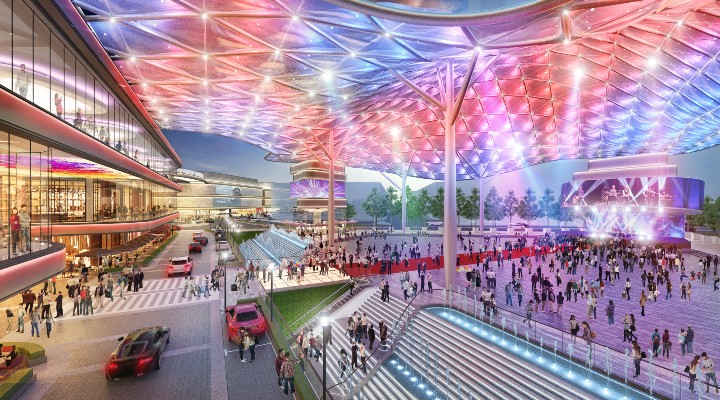The retail industry in Malaysia has struggled during Covid, but shopping centre Pavilion in Kuala Lumpur has continued to find a way to reach consumers. Here, we chat with CEO of retail, Dato’ Joyce Yap, about the future of malls and how sector have evolved in the past year. Inside Retail: Malaysian retail has been reported to be at an all-time low. What are your thoughts on how the retail landscape is travelling at the moment? Joyce Yap: The last year was challenging for the whole Malaysian r
sian retail industry. Likewise, Pavilion KL has not been spared from the impact of the pandemic. I am cautiously optimistic that the retail sector is heading towards recovery this year, and we are already starting to see some positive indicators. Hopefully the pandemic will be brought under control and we will not see another lockdown.
From a big-picture view, previous trends have shown that in the aftermath of major crises like — the 1997 Asian financial crisis and the 2007 global financial crisis — the retail industry tends to rebound. We hope this is an indication of things to come.
We saw this play out on a smaller scale at Pavilion KL during the Recovery Movement Control Order (MCO) last June. Footfall at Pavilion KL reached as high as 75-80 per cent while sales recovered to about 50-60 per cent. In December, the sales and visitors at Pavilion KL shot up, where footfall traffic went up by almost 90 per cent, from the first MCO lows of 20-30 per cent. Sales followed a similar trend, increasing 60-70 per cent from a low of about 20 per cent.
It’s encouraging to observe similar trends in countries like China, where trends such as “revenge shopping” are aiding the country’s speedy economic recovery. In fact, China saw its economy strengthen in November 2020, with retail sales expanding by five per cent.
Hopefully, as vaccines roll out across Southeast Asia, and the eventual relaxation of the MCO, will set the retail industry firmly on the path to recovery and growth. We look forward to footfall in the malls returning to pre-pandemic levels, and are excited to welcome shoppers to Pavilion Bukit Jalil, which opens at the end of the year.
IR: How would you describe 2020 for Pavilion last year, and what were some of the interesting ways that the business pivoted? What were some of the initiatives that you launched last year that have continued into this year?
JY: Last year was challenging for Pavilion Kuala Lumpur, and while we had to navigate a variety of new challenges that came with the pandemic, it has also been a year that pushed us to innovate and be creative in order to adapt to this new retail landscape.
Despite the challenging retail landscape during the MCO last year, our occupancy rate has remained stable. In fact, we even welcomed more than 48 new tenants to Pavilion KL, including first-in-Malaysia outlets from prestige brands like % Arabica from Japan, Kam’s Roast from Hong Kong, Objects, and Harriston Chocolatier Cafe. We are expecting several more openings in the coming months, including the first Dadi Cinema in Malaysia, which is set to launch later this year.
However, we recognise that several tenants were adversely affected last year, especially during the first MCO when only 35 per cent of our tenant mix were permitted to operate. To help ease the burden of tenants who were severely impacted, we offered rental rebates. At the same time, we facilitated cost-saving practices such as flexi operating hours to tenants in need to help cut down their expenses. We are practising cost cutting exercises internally to save costs wherever we can.
We have continuously worked with all our tenants to come up with robust marketing strategies to encourage customer traffic and spending, including creating promotional areas at high traffic areas, assisting with shopping and dining vouchers, and continuing with our shopper rewards and redemption programs.
IR: When the MCO took place in Malaysia, what was that experience like for Pavilion and what were the trends that you observed?
JY: The pandemic has brought on unprecedented challenges for retailers. It is the survival of the fittest and those with diversified business models were best equipped to pivot to the fast-changing retail environment, and adapt to evolving consumer behaviour — putting them in a better position to survive and grow during the pandemic.
Many tenants have realised the benefits of using multiple channels to reach out to their customers and offer an omni-channel experience. Businesses that offer customers both physical and online store options tend to see higher customer engagement and sales.
IR: How would you describe Malaysian customers’ current lifestyles and shopping behaviours, and how is Pavilion catering to that?
JY: Consumers and their needs have rapidly evolved in the past year. The demand for personalised customer experiences has increased. In order to fulfil customer demands and win their hearts, we, as retailers, need to understand and cater to their changing behaviour and trends.
For 2021, I see personalisation and customer insight-related technologies making the biggest impact as they become more robust and accessible. The next generation of personalisation will enable retailers to target both known and anonymous visitors in a cross-device and cross-channel shopping environment.
IR: Given the rise in e-commerce in the past year, how do you think consumers feel about bricks-and-mortar stores and what do you think retailers need to do to keep people coming back in-store?
JY: Despite the accelerated pace of online shopping, I don’t believe that offline retail will ever be replaced. Online and offline retail will co-exist, but I believe that shoppers will still value the sensory and tactile experience of offline shopping.
Retail Group Malaysia (RGM) predicts that the retail industry will recover this year, growing at a forecast of 4.9 per cent (RM95 billion in total retail sales), and all retail sub-sectors such as fashion, department stores and grocery are expected to rebound. This is because retail offers certain experiences that online shopping simply cannot replicate.
Let’s look at purchasing a handbag from a luxury brand for example. Making such a purchase is all about the physical shopping experience and customer service that adds to the prestige of making such an investment. Touching leather goods to determine their quality and luxuriousness, or smelling an expensive perfume to fully appreciate the scent — all these are thrilling parts of the shopping experience that are exclusive to physical purchasing. As long as we can keep shoppers feeling safe in shopping malls as they have these experiences, they will keep coming back.
IR: What are your thoughts on the future of shopping centres in Malaysia and what are some of the challenges and opportunities for the sector?
JY: We are already seeing a radical move towards an omni-channel retail experience, with more retailers moving from online to physical stores. Retailers need to embrace the omni-channel approach and see the rise of e-commerce as a complementary source of growth rather than competition. Embracing digital technologies and services is not a disruption, but provides an additional channel for branding, reaching a wider base of consumers and increasing footfall.
It is clear that consumers don’t limit themselves to a single channel, and therefore neither should we. If we don’t embrace the emerging trends model, we risk our own long-term success. Retailers that solely rely on traditional outreach formats must adapt or get buried as the industry constantly reshapes and redefines consumer expectations.
I believe the future of shopping is also a hyper-personalised and experiential customer experience, powered by the hybrid model of online and offline shopping. This means stores providing and recommending what the customer needs, when they need it, with the power of data and AI. It also means having a unique in-store experience with optimised store layouts, mall facilities, customer service and of course, safety measures.
IR: Can you give some great examples of your online-to-offline (O2O) tenants and what they’re doing to offer an omnichannel experience for customers?
JY: As part of Pavilion KL’s Welcome Back campaign after the MCO, we worked closely with tenants to come up with O2O marketing strategies with the aim of driving traffic to the mall and increasing sales.
With Pavilion KL’s Virtual Personal Shopper, we gave shoppers a chance to engage in a virtual in-store experience from the comfort of their homes. Through a series of video snippets on Instagram Stories, shoppers were taken on a virtual tour of the store to showcase the range of products available in-store. The goal is to entice shoppers with new arrivals and signature looks from luxury brands, and to encourage shoppers to visit the store in-person.
We also rolled out the Pavilion KL Shopping Concierge for our tenants Fendi, Gucci, MCM and Valentino. With this initiative, shoppers were able to browse through the collections on the respective brand’s pages, place their orders on WhatsApp, and schedule a date and time for them to pick up the items in-store.
IR: What do you think makes an excellent shopping centre experience in this day and age?
JY: An excellent shopping centre experience is not only about creating happy memories for shoppers but it also matches the customer’s desires and wants. It encompasses research, referrals, price points, variety, environment and budgets. Pavilion KL achieves this by hosting unique events such as Kuala Lumpur Fashion Week, which has a planned digital presence and builds into the shopping mall, transforming into a giant fashion runway with breathtaking decorations.
Pavilion Bukit Jalil — The Icon of Connectivity — is set to transform the southern corridor of Kuala Lumpur into the new cornerstone of metropolitan lifestyle and retail. Pavilion Bukit Jalil is an example of how a shopping mall targets the residential catchment area attached to the mall by featuring a multi-dimensional shopping experience, with a diverse and vibrant tenant mix made up of specialty retail, gastronomic F&B, leisure and entertainment.
Strategically located on a gross area of 3.48 million square feet in the heart of Bukit Jalil, this hyper-regional mall is well connected with excellent accessibility. Its well-planned infrastructure, easy access points to more than 5000 car park bays, coupled with an attractive mall facade, provides exposure from afar, giving tremendous advertising value and brand visibility.
Like Pavilion KL, Pavilion Bukit Jalil goes beyond retail. With a net lettable area of 1.8 million sqft, Pavilion Bukit Jalil connects communities through immersive experiences and leisure. Its impressive outdoor venue, Pavilion Bukit Jalil Piazza, which is covered with a 35-metre-high canopy, will be the preferred venue for outdoor entertainments, concerts, and events. Additionally, Pavilion’s grand annual festivities and year-long activities will take place at the Centre Court, while consumer fairs and exhibitions will thrive at the Exhibition Centre.
With five retail floors, Pavilion Bukit Jalil will be anchored by the newest Parkson departmental store in Malaysia. Other specialty anchors include the biggest Dadi Cinema in Malaysia; first-of-its-kind concept supermarket The Food Merchant, by the team behind Village Grocer; Harvey Norman Superstore; Blue Ice Snow Park, featuring aurora lights that simulate the Northern Lights for a unique night skating experience for families; karaoke and entertainment outlet K11 Karaoke; Grand Harbour restaurant; and kids’ store Toys R Us.
Unique to this mall will be the planned Asian-themed precincts offering retail, food, arts and culture from Japan, Thailand, China, Korea and Malaysia. They will seamlessly connect shoppers to each country through its diverse retail mix and functional layout, providing an elevated and interactive retail experience for shoppers.
This article was published in the Asian Retail Outlook report, sponsored by Salesforce. You can download it here.







